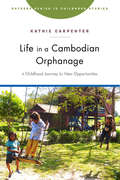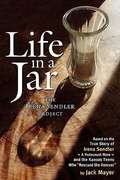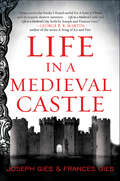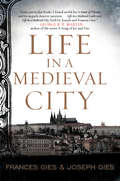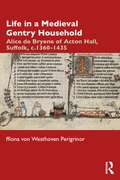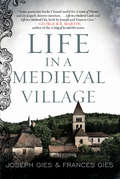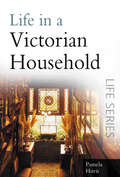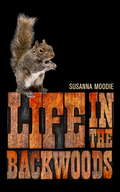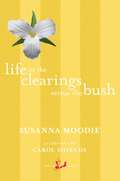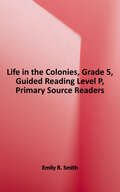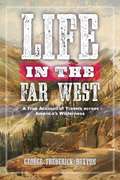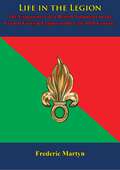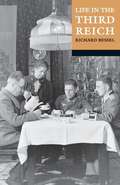- Table View
- List View
Life in a Cambodian Orphanage: A Childhood Journey for New Opportunities (Rutgers Series in Childhood Studies)
by Kathie CarpenterWhat is it like to grow up in an orphanage? What do residents themselves have to say about their experiences? Are there ways that orphanages can be designed to meet children's developmental needs and to provide them with necessities they are unable to receive in their home communities? In this book, detailed observations of children's daily life in a Cambodian orphanage are combined with follow-up interviews of the same children after they have grown and left the orphanage. Their thoughtful reflections show that the quality of care children receive is more important for their well-being than the site in which they receive it. Life in a Cambodian Orphanage situates orphanages within the social and political history of Cambodia, and shows that orphanages need not always be considered bleak sites of deprivation and despair. It suggests best practices for caring for vulnerable children regardless of the setting in which they are living.
Life in a Cave
by Paul JordanWhat was it like to be a caveman? What sort of house would you live in? What sort of clothes would you wear? Paul Jordan takes us back in time to see what it was really like to live in prehistoric times, what kind of animals we would have shared the land with, and what our daily life would involve. How would you have managed in this strange and difficult world?
Life in a Jar: The Irena Sendler Project
by Jack MayerDuring World War II, Irena Sendler, a Polish Catholic social worker, organized a rescue network of fellow social workers to save 2,500 Jewish children from certain death in the Warsaw ghetto. Incredibly, after the war her heroism, like that of many others, was suppressed by communist Poland and remained virtually unknown for 60 years. Unknown, that is, until three high school girls from an economically depressed, rural school district in southeast Kansas stumbled upon a tantalizing reference to Sendler's rescues, which they fashioned into a history project, a play they called Life in a Jar. Their innocent drama was first seen in Kansas, then the Midwest, then New York, Los Angeles, Montreal, and finally Poland, where they elevated Irena Sendler to a national hero, championing her legacy of tolerance and respect for all people. Life in a Jar: The Irena Sendler Project is a Holocaust history and more. It is the inspirational story of Protestant students from Kansas, each carrying her own painful burden, each called in her own complex way to the history of a Catholic woman who knocked on Jewish doors in the Warsaw ghetto and, in Sendler's own words, "tried to talk the mothers out of their children." Inspired by Irena Sendler, they are living examples of the power of one person to change the world and models for young people everywhere. ***** 60% of the sales of this book are donated to the Irena Sendler/Life in a Jar Foundation. The foundation promotes Irena Sendler's legacy and encourages educators and students to emulate the project by focusing on unsung heroes in history to teach respect and understanding among all people, regardless of race, religion, or creed.
Life in a Medieval Castle
by Brenda Ralph LewisHow would you feel if you woke up in a medieval castle tomorrow morning? What would your bed be like? What would you eat? What sights and smells would be around you? Whisking you back in time, this little book will show you exactly what it would be like to be there.
Life in a Medieval Castle (Medieval Life)
by Frances Gies Joseph GiesThe definitive classic used as a source for Game of Thrones: “The Gieses succeed in making a remote and unfamiliar world accessible.” —Kirkus ReviewsA bestseller by two widely respected historians, Joseph and Frances Gies’s Life in a Medieval Castle remains a timeless work of popular medieval scholarship.Focusing on Chepstow, an English castle on the Welsh border that survived the turbulent Middle Ages with a relative lack of violence, the book offers an exquisite portrait of what day-to-day life was actually like during the era, and of the key role the castle played. The Gieses take us through the full cycle of a medieval year, dictated by the rhythms of the harvest. We learn what lords and serfs alike would have worn, eaten, and done for leisure—and of the outside threats the castle strove to keep at bay.“The authors allow medieval man and woman to speak for themselves through selections from past journals, songs, even account books.” —TimeIncludes photographs and maps
Life in a Medieval City (Medieval Life #1)
by Frances Gies Joseph GiesFor students, researchers, and history lovers, a look at day-to-day life in a rarely explored era. "About life and death, midwives and funerals, business, books and authors, and town government."--Choice
Life in a Medieval Gentry Household: Alice de Bryene of Acton Hall, Suffolk, c.1360-1435
by ffiona von Westhoven PerigrinorIn the Middle Ages the household was such a fundamental part of the social structure that the post-1350 era has been termed ‘the Age of the Household.’ Academic studies have generally focused on the grand, itinerant households of the wealthy aristocracy, illuminating the lifestyles and pastimes of this elite class. Using the household accounts of Alice de Bryene, a widowed gentlewoman, together with bailiffs’ and stewards’ reports from her home in Suffolk and other estates further afield, this richly detailed study paints a vivid portrait of the lives of ordinary people in the medieval countryside, of festivals and feast days, marriage and monuments, family loyalties and betrayals, life and death, the rhythms of the working day and year, and the changing scene in the wider world beyond the household.
Life in a Medieval Village
by Frances Gies Joseph GiesA lively, detailed picture of village life in the Middle Ages by the authors of Life in a Medieval City and Life in a Medieval Castle. "A good general introduction to the history of this period."--Los Angeles Times
Life in a Medieval Village
by Frances Gies Joseph GiesA lively, detailed picture of village life in the Middle Ages by the authors of Life in a Medieval City and Life in a Medieval Castle. "A good general introduction to the history of this period."--Los Angeles Times
Life in a Medieval Village
by Frances Gies Joseph GiesThe reissue of Joseph and Frances Gies's classic bestseller on life in medieval villages.This new reissue of Life in a Medieval Village, by respected historians Joseph and Frances Gies, paints a lively, convincing portrait of rural people at work and at play in the Middle Ages. Focusing on the village of Elton, in the English East Midlands, the Gieses detail the agricultural advances that made communal living possible, explain what domestic life was like for serf and lord alike, and describe the central role of the church in maintaining social harmony. Though the main focus is on Elton, c. 1300, the Gieses supply enlightening historical context on the origin, development, and decline of the European village, itself an invention of the Middle Ages.Meticulously researched, Life in a Medieval Village is a remarkable account that illustrates the captivating world of the Middle Ages and demonstrates what it was like to live during a fascinating--and often misunderstood--era.
Life in a Time of Pestilence: The Great Castilian Plague of 1596–1601
by Ruth MacKayFrom the Middle Ages onwards, deadly epidemics swept through portions of Spain repeatedly, but the Castilian Plague at the end of the sixteenth century was especially terrible. In late 1596, a ship carrying the plague docked in Santander, and over the next five years the disease killed some 500,000 people in Castile, around 10 percent of the population. Plague is traditionally understood to have triggered chaos and madness. By contrast, Ruth Mackay focuses on the sites of everyday life, exploring how beliefs, practices, laws, and relationships endured even under the onslaught of disease. She takes an original and holistic approach to understanding the impact of plague, and explores how the epidemic was understood and managed by everyday people. Offering a fresh perspective on the social, political, and economic history of Spain, this original and engaging book demonstrates how, even in the midst of chaos, life carried on.
Life in a Victorian Household
by Pamela HornWhat was it like to live in a Victorian household? What time did the servants have to get up? What was the food like and who cooked it? How did the clothing differ for the different types of servants? How much did the servants get paid? This fascinating book takes you back in time and shows you what it was really like to live in Victorian times, for those both above and below stairs, and what sights and smells would be around you.
Life in an Egyptian Village in Late Antiquity: Aphrodito Before and After the Islamic Conquest
by Giovanni R. RuffiniMost ancient history focuses on the urban elite. Papyrology explores the daily lives of the more typical men and women in antiquity. Aphrodito, a village in sixth-century AD Egypt, is antiquity's best source for micro-level social history. The archive of Dioskoros of Aphrodito introduces thousands of people living the normal business of their lives: loans, rent contracts, work agreements, marriage, divorce. In exceptional cases, the papyri show raw conflict: theft, plunder, murder. Throughout, Dioskoros struggles to keep his family in power in Aphrodito, and to keep Aphrodito independent from the local tax collectors. The emerging picture is a different vision of Roman late antiquity than what we see from the view of the urban elites. It is a world of free peasants building networks of trust largely beyond the reach of the state. Aphrodito's eighth-century AD papyri show that this world dies in the early years of Islamic rule.
Life in the Backwoods
by Susanna MoodieLife in the Backwoods in Susanna Moodie's follow-up to her first memoir, Roughing It in the Bush. She and her family leave the home they've carved out in the bush for new opportunities in Canada's frontier. Once again she chronicles their struggles, sorrows, and joys as they try to build a life for themselves in a place that can be equal parts bounteous and unforgiving. Penguin Random House Canada is proud to bring you classic works of literature in e-book form, with the highest quality production values. Find more today and rediscover books you never knew you loved.
Life in the Clearings versus the Bush (New Canadian Library)
by Susanna Moodie Carol ShieldsIn the sequel to Roughing It in the Bush, Susanna Moodie portrays the relatively sophisticated society springing up in the clearings along Lake Ontario. During a trip from Belleville to Niagara Falls, Moodie acts as a meticulous observer of the social customs and practices of the times.Invaluable as social history and as a candid self-portrait, Life in the Clearings versus the Bush chronicles, with wit and wisdom, Canadian society in the mid-19th century.The NCL edition is an unabridged reprint of the complete original text.From the Paperback edition.
Life in the Colonies (Primary Source Readers)
by Emily R. SmithYoung readers will be fascinated to learn what life was like for the colonists in early America. The detailed images and easy-to-read text explore such topics as Puritans, the Mayflower Compact, House of Burgesses, the Navigation Acts, and slavery. <p><p>Along with brief biographies on colonists and Indians like John Smith, William Penn, Pocahontas, and John Rolfe, this engaging reader explains the means of survival and living through farming, colonial crops, and plantations. A table of contents and glossary are provided to enhance readers' understanding of the content and vocabulary.
Life in the Far West: A True Account of Travels across America's Wilderness
by George Frederick RuxtonGeorge Frederick Ruxton was an explorer and adventurer extraordinaire. Born in England in 1820, he followed in his family’s footsteps and entered the military at the age of thirteen. He quickly became a decorated soldier, serving in Spain, where he fought for Queen Isabella II in the Carlist civil war and was made a Spanish knight at seventeen, as well as in Ireland and Canada. But the rigidity of military life was not for him. In 1843 Ruxton followed his wanderlust; he sold his commission and roamed freely for a season through the remote woods of southern Canada and northern New York, hunting and living off the land. Ruxton never forgot his travels through remote America, and, after journeying through Africa, he would return in 1847. Starting in Mexico and the new American southwest territories, Ruxton would go on to travel more than two thousand miles, finally reaching present-day Colorado. Upon returning to England, Ruxton, using the pen name La Bonté, would begin to detail his travels through articles under the title Life in the Far West. First published in book form in 1849, Life in the Far West describes the amazing true adventures of George Frederick Ruxton as he forges a path through the yet-untamed wilderness of a young America, seeing firsthand the relationships between the US Army and Comanche Indians and the incredible lifestyles of Colorado mountain men. With a literary style that makes it feel more like a novel than the true account it is, Life in the Far West is the compelling and ambitious account of a true explorer. Skyhorse Publishing, as well as our Arcade imprint, are proud to publish a broad range of books for readers interested in history--books about World War II, the Third Reich, Hitler and his henchmen, the JFK assassination, conspiracies, the American Civil War, the American Revolution, gladiators, Vikings, ancient Rome, medieval times, the old West, and much more. While not every title we publish becomes a New York Times bestseller or a national bestseller, we are committed to books on subjects that are sometimes overlooked and to authors whose work might not otherwise find a home.
Life in the Georgian Court
by Catherine CurzonThis lively history of Europe&’s royal families through the 18th and early 19th centuries reveals the decadence and danger of court life. As the glittering Hanoverian court gives birth to the British Georgian era, a golden age of royalty dawns in Europe. Houses rise and fall, births, marriages and scandals change the course of history. Meanwhile, in France, Revolution stalks the land. Life in the Georgian Court pulls back the curtain on the opulent court of the doomed Bourbons, the absolutist powerhouse of Romanov Russia, and the epoch-defining royal family whose kings gave their name to the era, the House of Hanover. Beneath the powdered wigs and robes of state were real people living lives of romance, tragedy, intrigue and eccentricity. Historian Catherine Curzon reveals the private lives of these very public figures, vividly recounting the arranged marriages that turned to love or hate and the scandals that rocked polite society. Here the former wife of a king spends three decades in lonely captivity, King George IV makes scandalous eyes at the toast of the London stage, and Marie Antoinette begins her final journey through Paris as her son sits alone in a forgotten prison cell.Life in the Georgian Court is a privileged peek into the glamorous, tragic and iconic courts of the Georgian world, where even a king could take nothing for granted.
Life in the Himalaya: An Ecosystem at Risk
by Maharaj K. PanditThe collision of the Indian and Eurasian plates 50 million years ago created the Himalaya, along with massive glaciers, intensified monsoon, turbulent rivers, and an efflorescence of ecosystems. Today, the Himalaya is at risk of catastrophic loss of life. Maharaj Pandit outlines the mountain’s past in order to map a way toward a sustainable future.
Life in the Leatherwoods
by Brooks Blevins John Quincy Wolf Gene HydeLife in the Leatherwoods is one of the country's most delightful childhood memoirs, penned by an Ozark native with a keen, observant eye and a gift for narrative. John Quincy Wolf's relaxed style and colorful characters resemble those of another chronicler of nineteenth-century rural life, Laura Ingalls Wilder. Wolf's acerbic wit and lucid prose infuse the White River pioneers of his story with such life that the reader participates vicariously in their log rollings, house-raisings, spelling bees, hog killings, soap making, country dances, and camp meetings. Originally published by Memphis State University Press in 1974, this new edition includes additional writings of John Q. Wolf and a continuation of the autobiographical narrative after his 1887 move to Batesville. Wolf's writings are valuable resources for southern historians, folklorists, general readers, and scholars of Ozarkiana because they provide a rare glimpse into the social and family life of a largely misunderstood and stereotyped people--the independent hill farmers of the Arkansas Ozarks of the 1870s and 1880s. With Life in the Leatherwoods, Wolf bestows a benediction upon a society that existed vibrantly and humorously in his memory--one that has now forever disappeared from the American countryside. Originally published by Memphis State University Press in 1974, this new edition includes additional writings of John Q. Wolf and a continuation of the autobiographical narrative after his 1887 move to Batesville. Wolf's writings are valuable resources for southern historians, folklorists, general readers, and scholars of Ozarkiana because they provide a rare glimpse into the social and family life of a largely misunderstood and stereotyped people--the independent hill farmers of the Arkansas Ozarks of the 1870s and 1880s. With Life in the Leatherwoods, Wolf bestows a benediction upon a society that existed vibrantly and humorously in his memory--one that has now forever disappeared from the American countryside.
Life in the Legion: The Experiences of a British Volunteer in the French Foreign Legion in the Late 19th Century
by Frederic MartynOn campaign under the tricolor“This is an essential book for all those interested in the French Foreign Legion because it is a brilliant first hand account written by an English 'gentleman volunteer' who experienced 'life in the legion' in the late 1880's and who had previously been a serving officer in one of the cavalry regiments of the British Army. Far from being a tale of hardship and abuse, the author had nothing but admiration for the Legion and—as an experienced soldier—obviously thoroughly enjoyed the five years he spent serving in its ranks. The writer quite simply could not have enough action and he volunteered to serve in Tonkin, Dahomey and against the Tuareg tribesmen of North Africa. In consequence this book is full of colourful and detailed campaign and battle action which is compellingly recounted by a fighting soldier more than capable of putting his engrossing story into words. Highly recommended.”-Print ed.
Life in the Third Reich
by Richard BesselThe essays presented here by eight leading historians shed fresh light on familiar topics, the role of political violence in Nazi seizure of power, the German view of Hitler himself, and also focus upon less well-known aspects of life in the Third Reich, such as village life, the treatment of 'social outcasts', and the Germans own retrospective view of this period of their history.
Life in the Victorian Asylum: The World of Nineteenth Century Mental Health Care
by Mark StevensA vivid portrait of the day-to-day experience in the public asylums of nineteenth-century England, by the bestselling author of Broadmoor Revealed. Life in the Victorian Asylum reconstructs the lost world of nineteenth-century public asylums. This fresh take on the history of mental health reveals why county asylums were built, the sort of people they housed, and the treatments they received, as well as the enduring legacy of these remarkable institutions. Mark Stevens, a professional archivist, and expert on asylum records, delves into Victorian mental health hospital documents to recreate the experience of entering an asylum and being treated there—perhaps for a lifetime. Praise for Broadmoor Revealed &“Superb.&” —Family Tree magazine &“Detailed and thoughtful.&” —Times Literary Supplement &“Paints a fascinating picture.&” —Who Do You Think You Are? magazine
Life in the Victorian Kitchen: Culinary Secrets and Servants' Stories
by Karen FoyA fascinating and deeply researched behind-the-scenes journey into Victorian-era kitchens, with authentic nineteenth-century techniques, tips, and recipes. Have you ever wondered what life was like for domestic servants, the etiquette involved during upper class banquets, or simply wished for a glimpse of day-to-day life in the Victorian kitchen? During the nineteenth century, the kitchen was a place where culinary worlds collided, bridging the gap between social classes. From the rural cottage to the well-staffed country house, Karen Foy takes readers on an entertaining and informative journey through a lost culinary world, uncovering the customs, traditions, and history surrounding some of Britain&’s best loved dishes. Discover nineteenth-century tips, techniques, stories, and superstitions. Try your hand at using an egg to foretell the future, or timeless recipes for everything from apple wine to sheep&’s head pie.
Life in the Victorian and Edwardian Workhouse
by Michelle HiggsLife in a workhouse during the Victorian and Edwardian eras has been popularly characterised as a brutal existence. Charles Dickens famously portrayed workhouse inmates as being dirty, neglected, overworked and at the mercy of exploitative masters. While there were undoubtedly establishments that conformed to this stereotype, there is also evidence of a more enlightened approach that has not yet come to public attention. This book establishes a true picture of what life was like in a workhouse, of why inmates entered them and of what they had to endure in their day-to-day routine.A comprehensive overview of the workshouse system gives a real and compelling insight into social and moral reasons behind their growth in the Victorian era, while the kind of distinctions that were drawn between inmates are looked into, which, along with the social stigma of having been a workhouse inmate, tell us much about class attitudes of the time.The book also looks at living conditions and duties of the staff who, in many ways, were prisoners of the workhouse. Michelle Higgs combines thorough research with a fresh outlook on a crucial period in British history, and in doing so paints a vivid portrait of an era and its social standards that continues to fascinate, and tells us much about the society we live in today.
